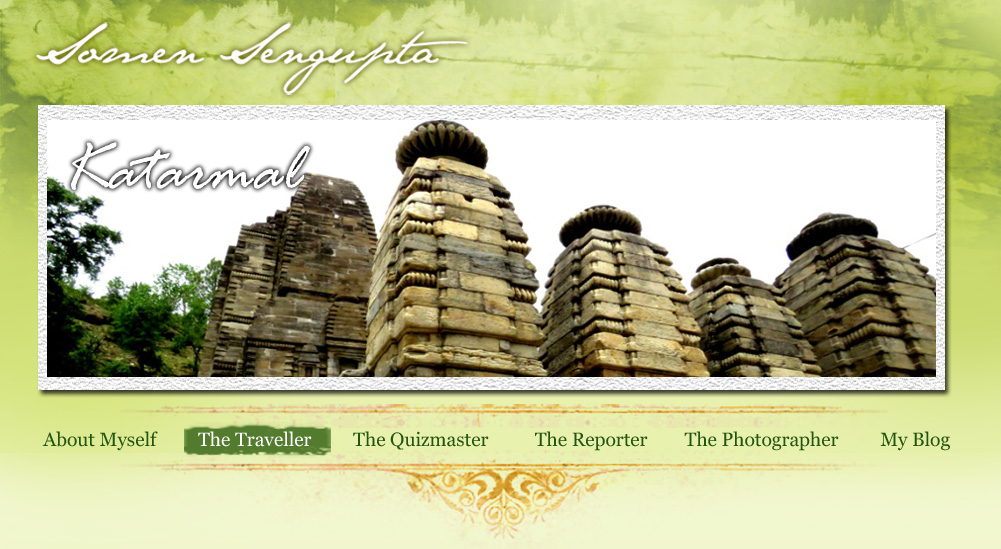|
Somen Sengupta visited the sun temple complex of Katarmal built more than 900 years ago and came away feeling blessed.
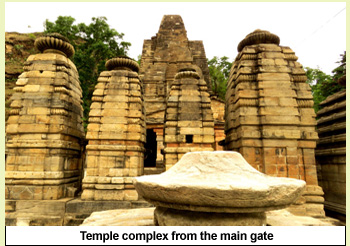 THE Konark Sun Temple of Odisha is almost an icon now, as much because of its close proximity to Puri and Bhubaneswar as also the Unesco tag of being a World
Heritage Site. Pictures and information of the Martand Sun Temple of Kashmir and the Modhera Sun Temple of Gujarat abound in social media, yet the biggest sun
temple in the Kumaon region still remains in oblivion. THE Konark Sun Temple of Odisha is almost an icon now, as much because of its close proximity to Puri and Bhubaneswar as also the Unesco tag of being a World
Heritage Site. Pictures and information of the Martand Sun Temple of Kashmir and the Modhera Sun Temple of Gujarat abound in social media, yet the biggest sun
temple in the Kumaon region still remains in oblivion.
My driver clarified that at this time of year no one visited the Katarmal temple. When I told him the purpose of my visit was to witness history and enjoy archaeological wonders, he took me as lightly as possible. A pleasant 15-km drive from Almora finally ended at the
foothills of the Kumaon range
of the Himalayas in
Uttarakhand. From here one
has to trek uphill for another
1.5 km to witness a marvel of
time.
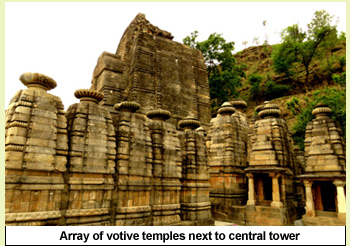 Since the morning the sky
had been overcast with black
clouds and a heavy shower
was imminent. The climb was
rocky and tough, but
manageable. As I neared the
almost 1,000-year-old shrine, I
finally saw the eye-catching
tower of the central
monument of the majestic
temple complex of Katarmal
an exceptional yet lesserknown
sun temple of India. Since the morning the sky
had been overcast with black
clouds and a heavy shower
was imminent. The climb was
rocky and tough, but
manageable. As I neared the
almost 1,000-year-old shrine, I
finally saw the eye-catching
tower of the central
monument of the majestic
temple complex of Katarmal
an exceptional yet lesserknown
sun temple of India.
The Archaeological Survey
of India signboard read,
Sustain your heritage and
feel glorious. Built in the
13th century by a king named
Katarmalla of the Katyuri
dynasty of Kumaon who ruled
the central Himalayan region,
the small yet well-kept
archaeological site contains an
array of small temples
decorating the central shrine.
The man I met there claimed to
be working for the ASI and,
according to him, this temple was
linked to the Mahabharata. When
the Pandavas were in exile, they
came to this place and tried to build
all the temples overnight. But having
failed to do so, they left the place
with the central temple incomplete.
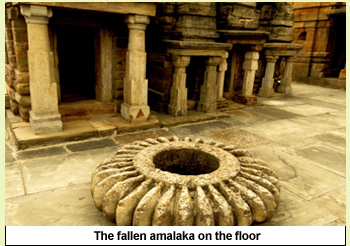 I enjoyed this legend but took it
with a grain of salt, as Id already
found a huge Amalaka (a circular
stone ring placed on the top of the
temples pinnacle) had fallen to the ground, clearly indicating that the
tower of the central shrine was once
a complete one and had later
collapsed. In addition to this
Amalaka, there were many small
and big stones inscribed with
excellent floral motifs, Hindu signs and Brahmanical divine figures. I enjoyed this legend but took it
with a grain of salt, as Id already
found a huge Amalaka (a circular
stone ring placed on the top of the
temples pinnacle) had fallen to the ground, clearly indicating that the
tower of the central shrine was once
a complete one and had later
collapsed. In addition to this
Amalaka, there were many small
and big stones inscribed with
excellent floral motifs, Hindu signs and Brahmanical divine figures.
A closer look made it obvious that
the original temple was built with
brick and wood. Later, it was
modified by many hands and the
stone slabs were added. When the
ASI found the temple more than 100 years ago in a state of
dilapidation, many wooden
crafts were discovered there.
From the inscriptions on
the pillars and the
architectural features, it was
assumed that this temple was
built in the 13th century and
all the small temples were
added later.
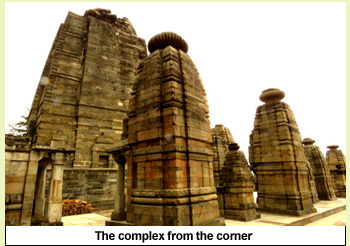 Entering the central shrine I
was thrilled to feel that more
than 900 years ago huge slabs
of stones were quarried and
transported to the hilltop to
revere Buraadhitya, the old
Sun God. At the complex, a
stone slab placed by the ASI
describes the temples
architecture. These temples
were built on a raised stone
plinth with the curvilinear
pinnacle of the Naggar style.
Apart from the Sun God,
other artistic metallic statues
of deities were also present,
including Shiva, Parvati, Laxmi
and Narayana. Entering the central shrine I
was thrilled to feel that more
than 900 years ago huge slabs
of stones were quarried and
transported to the hilltop to
revere Buraadhitya, the old
Sun God. At the complex, a
stone slab placed by the ASI
describes the temples
architecture. These temples
were built on a raised stone
plinth with the curvilinear
pinnacle of the Naggar style.
Apart from the Sun God,
other artistic metallic statues
of deities were also present,
including Shiva, Parvati, Laxmi
and Narayana.
The entrance to the
sanctum was once decorated
with an excellent wooden
door panel that is now kept at
the National Museum of New
Delhi to protect it from
vandalism. There are a total of
44 smaller temples, all in the
Naggar style, with an
Amalaka on top and a square
sanctum where the deity is
housed. Smaller temples are
made of the same stone but
their difference in size and
shape clearly prove their eras
of erection.
Having done with my tryst
with Katarmal, I was expected
to make an offering to the
Sun God and carry his
blessings back to my family. I
declined because I felt that by
exploring the tallest temple of
Kumaon and witnessing a
glorious saga of the past Id
already derived my share of
blessings.
I then looked up and saw black
clouds gathering, but as I made
haste to reach my car, these clouds
suddenly disappeared and the sun
flooded the sky. I realised that Id
really received the blessings of
Buraadhitya.
This article was published on 3rd July 2016 in The Statesman.
Click here to view the original article
|
